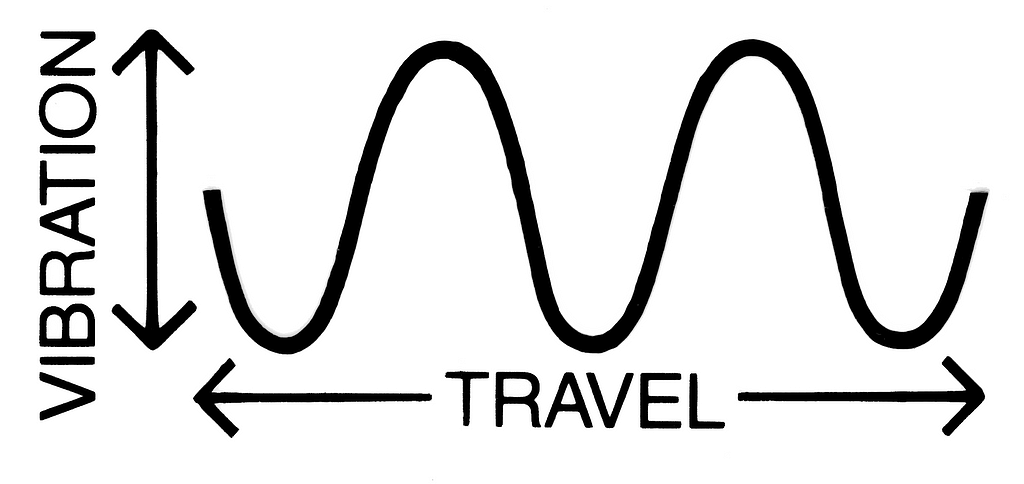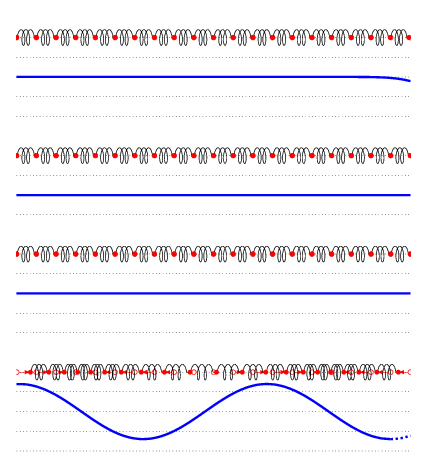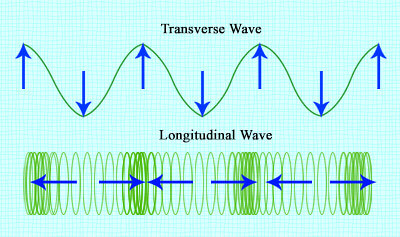Types of Waves
In this article, we are going to have a look at the various kinds of waves, their basic properties, and some terms related to waves.
But before we do so, let’s understand what waves are.
 Table of Contents
Table of Contents- What is a Wave?
- Various types of waves
- Terms related to Waves
What is a Wave?
Wave is a form of vibratory disturbance which travels through a material medium due to the repeated periodic motion of the particles of the medium about their mean position.
Kindly note that it’s the disturbance pattern that travels, and not the material particles of the medium. In other words, waves carry energy from one point in the medium to another, without any actual movement, flow, or physical transfer of the medium/matter.
So, as a wave propagates from one point to another, it transports disturbance pattern, energy and thus information form one place to another.
 Note
NotePulse is a wave too. It’s just that when the disturbance is sudden and its duration is short, we prefer to call it a pulse. Imagine a pulsating neutron star that is rotating on its axis thousands of times per second.
When we study pendulum or a spring in motion, we are observing a single object in oscillation. However, when we talk about waves we are talking about many objects in oscillation, e.g. in a material medium (air molecules in the air medium, or water molecules in the water medium, etc.)
The molecules of such a medium are connected t each other by elastic forces. If one is disturbed, say it’s set in motion, then it will transit that disturbance to all others near it and they will move too.
Let’s see some real-life examples.
If we drop a pebble in the pond water, we get to see outward moving ripples of water. It causes an illusion in our mind that the water itself is moving out from the point of contact of the pebble and the water surface. But that’s not the case. In fact, it’s the disturbance that moves out. You may experimentally verify it by putting some cork pieces on the water surface. As the disturbance passes them, you will see that they move up and down, rather than moving away from the centre of disturbance. It means that the water itself is not moving out.
When we speak, it is the sound waves that move outward from our mouth, not the air itself.
 Note
NoteKindly note that, though in the definition given above we have mentioned material medium through which a wave passes, it’s not always necessary. There are some waves that do not need any medium to travel, e.g. light wave, which can travel even through vacuum.
Various types of waves
We can broadly classify waves into three categories:
- Mechanical Waves (or Elastic Waves)
- Electromagnetic Waves
- Matter Waves
Let’s learn about these types of waves in more detail.
Mechanical Waves
Mechanical Waves require a medium for propagation, be it solid, liquid, or gas. They cannot travel/ propagate through vacuum. That’s because they depend on the elastic properties of the medium. When they pass through the medium, its constituent particles oscillate.
Mechanical Waves are most familiar type of waves. Some examples of mechanical waves are: sound waves, seismic waves, water waves, waves on a string, etc.
Types of Mechanical Waves
Mechanical waves are of two types: Transverse waves and Longitudinal waves.
Transverse waves
When transverse waves pass through a medium, the constituents of the medium oscillate perpendicular to the direction of wave propagation. That’s why these waves can be polarized.
Such waves need rigid medium. That’s why they can only travel in solids and on surface of liquids. They cannot propagate through gases and inside liquids.
Transverse waves form crests and troughs as they travel.

- Crest: The position of maximum displacement in the upward direction.
- Trough: The position of maximum displacement in the downward direction.
Wavelength (λ) of a transverse wave = Distance between two adjacent crests or troughs.
Longitudinal waves
When longitudinal waves pass through a medium, the constituents of the medium oscillate along the direction of wave propagation. That’s why these waves cannot be polarized.
Such waves can travel in solids, liquids, and gases.
Transverse waves form compressions and rarefactions as they travel. That is, the density and pressure in the medium becomes maximum at few points and minimum at other few points.

- Compression: The points where the density and pressure in the medium is maximum.
- Rarefaction: The points where the density and pressure in the medium is minimum.
Electromagnetic Waves
Electromagnetic Waves can travel through medium and vacuum alike. That is, they do not necessarily require a medium.
Some examples of electromagnetic waves are: light, radio waves, X-rays, etc.
 Note
NoteEarlier, even light was assumed to be a mechanical wave, i.e. an elastic wave. As mechanical wave needs a medium to propagate, a hypothetical medium called ether was proposed. However, presence of ether was never proved. In fact, Michelson-Morely experiment gave a negative result for ether drag. Hence, this hypothesis was discarded/abandoned.
 Note
NoteCathode rays, canal rays, α rays, β rays, sound waves and ultrasonic waves are not electromagnetic waves.
 Note
NoteAll electromagnetic waves travel through vacuum at the same speed. This speed is a constant, represented by the symbol c. Its value is 299,792,458 m/sec.
Matter Waves
Matter Waves are associated with subatomic particles (such as electrons, protons, neutrons, atoms and molecules), because these quantum size particles have both particle and wave nature. As these subatomic particles are constituents of matter, the waves associated with them are called matter waves.
These waves are conceptually a lot more abstract than mechanical or electro-magnetic waves, as they are related with quantum mechanical description of nature. But they are not limited to theory. They have found several practical applications too, e.g. electron microscopes utilize matter waves associated with electrons.
Terms related to Waves
Wavelength
It is the distance between two nearest points in a wave which are in the same phase of vibration. It is denoted by the symbol λ (Greek letter lambda).
In other words, it is the distance required to cover one complete oscillation of any particle of the medium.
- In a transverse wave: Wavelength is the distance between two consecutive/adjacent crests or troughs.
- In a longitudinal wave: Wavelength is the distance between two consecutive/adjacent compressions or rarefactions.
Time Period
It is the time taken by a wave to complete one vibration. It is denoted by the symbol T.
In other words, it is the time taken by the vibrations of the particles of the medium in completing one oscillation.
Frequency
It is the number of vibrations completed by a wave in one second. It is denoted by the symbol v (Greek letter nu), n, or f. Its SI unit is hertz.
In other words, it is the number of oscillations executed by the particles of the medium in one second.
Frequency (v) = 1 / Time period (T)
Amplitude
Amplitude of a wave is the maximum displacement (on both sides) from the mean/equilibrium position of the vibration of the particles of the medium. It is denoted by the symbol a.
Phase
Phase of a wave is the state of motion of a particle of the medium at a given point of time.
The state of motion of a particle at a particular time refers to both its position (i.e. where it is) and direction of motion at that instant.
Wave Speed
Wave Speed is the rate of the distance travelled by the wave/disturbance. It is denoted by the symbol v.
Wave speed (v) = Frequency (n) × Wavelength (λ).

